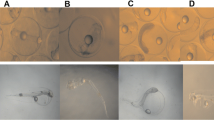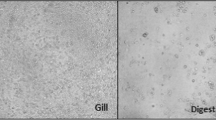Abstract
Established cell lines from brown bullhead catfish (BB) and rainbow trout (RTG-2) and primary cultures of cells derived from gill, fin, and gonad tissues from brown bullhead catfish were evaluated for use as bioindicators in the neutral red cytotoxicity assay. The BB and RTG-2 cells were compared after a 1 day exposure to chlorinated pesticides and after a 6-day exposure to various polycyclic aromatic hydrocarbons. The BB cells were more sensitive to both classes of chemicals. The sequence of toxicity for the BB cells was 4,4′-DDD, 4,4′-DDT > aldrin, 4,4′-DDE and 7,12-dimethylbenz(a)anthracene (DMBA) > 3-hydroxybenzo(a)pyrene (3-OH-B(a)P) > benzo(a)pyrene (B(a)P). For the RTG-2 cells, the sequence was aldrin > 4,4′-DDD > 4,4′-DDT > 4,4′-DDE and 3-OH-B(a)P > DMBA > B(a)P. The BB cells were also sensitive to benzo(b)fluoranthene, benzo(k)fluoranthene, benzo(a)anthracene, and trans-7,8-di-hydro-7,8-dihydroxybenzo(a)pyrene. The responses of BB and RTG-2 cells were compared with those of primary cultures after a 1 day exposure to B(a)P. After 1 day of exposure, the RTG-2 cells and primary cultures were more sensitive than the BB cells to B(a)P. Apparently, after 1 day of incubation the RTG-2 and primary cells metabolized greater amounts of B(a)P to cytotoxic metabolites, than did the BB cells. However, by 6 days of incubation, the BB cells were more sensitive to B(a)P than were the RTG-2 cells. A 6-day exposure to B(a)P was not performed with the primary cell cultures.
Similar content being viewed by others
References
Babich H, Borenfreund E (1987a) Aquatic pollutants testedin vitro with early passage fish cells. ATLA 15:116–122
—,— (1987b)In vitro cytotoxicity of organic polutants to bluegill sunfish (BF-2) cells. Environ Res 42:229–237
—,— (1987c) Polycyclic aromatic hydrocarbonin vitro cytotoxicity to bluegill BF-2 cells: mediation by S-9 microsomal fraction and temperature. Toxicol Lett 36:107–116.
—,— (1988) Structure-activity relationships for diorganotins, chlorinated benzenes and chlorinated anilines established with bluegill sunfish BF-2 cells. Fund Appl Toxicol 10:295–301
Babich H, Martin-Alguacil N, Borenfreund E (1987/1988) Mediating role of metabolic activation inin vitro cytotoxicity assays. Molec Toxicol 3:363–372
—,—,— (1989) Use of the rainbow trout hepatoma cell line, RTH-149, in a cytotoxicity assay. ATLA 17:67–71
Babich H, Puerner JA, Borenfreund E (1986)In vitro cytotoxicity of metals to bluegill (BF-2) cells. Arch Environ Contam Toxicol 15:31–37
Barker CJ, Rackham BD (1979) The induction of sister-chromatid exchanges in cultured fish cells (Ameca splendens) by carcinogenic mutagens. Mutat Res 68:381–387
Bols N, Boliska SA, Dixon DG, Hodson PV, Kaiser KE (1985) The use of fish cultures as an indicator of contaminant toxicity to fish. Aquat Toxicol 6:147–155
Borenfreund E, Puerner JA (1984) A simple quantitative procedure using monolayer cultures for cytotoxicity assays (HTD/NR-90). J Tiss Cult Meth 9:7–9
—,— (1985) Toxicity determinedin vitro by morphological alteration and neutral red absorption. Toxicol Lett 24:119–124
—,— (1986) Cytotoxicity of metals, metal-metal and metal-chelator combinations assayedin vitro. Toxicology 39:121–134
Bourne EW, Jones RW (1973) Effects of 7,12-dimethylbenz- (a)anthracene (DMBA) in fish cellsin vitro. Trans Amer Micros Soc 92:140–142
Cerini CP, Malsberger RG (1969) Fish cell and tissue culture. In: Fish physiology, Vol 3. Academic Press, New York, pp 253–301
Clark HF, Diamond L (1971) Comparative studies on the interaction of benzpyrene with cells derived from poikilothermic and homeothermic vertebrates. II. Effect of temperature of benzpyrene metabolism and cell multiplication. J Cell Physiol 77:385–392
Diamond L, Clark HF (1979) Comparative studies on the interaction of benzpyrene with cells derived from poikilothermic and homeothermic vertebrates. I. Metabolism of benzo(a)pyrene. J Natl Cancer Inst 45:1005–1011
Diamond L, Sardet C, Rothblatt CH (1968) The metabolism of 7,12-dimethylbenz(a)anthracene in cell cultures. Intern J Cancer 3:838–849
Geddie JE, Amin S, Huie K, Hecht SS (1987) Formation and tumorigenicity of benzo(b)fluoranthene metabolites in mouse epidermis. Carcinogenesis 8:1579–1584
Gelboin HV, Huberman E, Sachs L (1969) Enzymatic hydroxylation of benzo(a)pyrene and its relationship to cytotoxicity. Proc Natl Acad Sci 64:1180–1194
Greenlee WF, Poland A (1978) An improved assay of 7-ethoxycoumarinO-deethylase activity: induction of hepatic enzyme activity in C57BL/6J and DBA/2J mice by phenobarbital, 3-meth-ylcholanthrene and 2,3,7,8-tetrachlorodibenzo-p-dioxin. J Pharmacol Exp Ther 205:596–605
Jacobson M, Levin W, Poppers PJ, Wood AW, Conney AH (1974) Comparison of theO-dealkylation of 7-ethoxycoumarin and the hydroxylation of benzo(a)pyrene in human placenta. Clin Pharmacol Ther 16:701–710
Kocan RM, Powell DB (1985) Anaphase aberrations; anin vitro test for assessing the genotoxicity of individual chemicals and complex mixtures. In: Waters MD, Sandhu SS, Lewtas J, Claxton L, Strauss G, Nesnow S (eds) Short-term bioassays in the analyses of complex environmental mixtures, Vol 4. Plenum Publ Corp, New York, pp 75–86
Kocan RM, Landolt ML, Sabo KM (1979).In vitro toxicity of eight mutagens/carcinogens for three fish cell lines. Bull Environ Contam Toxicol 23:269–274
—,—,— (1982) Anaphase aberrations: A measure of genotoxicity in mutagen-treated fish cells. Environ Mutagen 4:181–189
Lowry DH, Rosenbrough NJ, Farr AL, Randall RJ (1951) Protein measurement with the Folin phenol reagent. J Biol Chem 193:265–275
Parkinson C, Agius C (1987a) Acute toxicity of DDT to fish cellsin vitro. Fd Chem Toxicol 24:591–592
—,— (1987b) The effects of solvents on the toxicity of DDT to fish cells. Arch Toxicol 11:240–242
Pohl RJ, Fouts JR (1980) A rapid method for assaying the metabolism of 7-ethoxyresorufin by microsomal subcellular fractions. Anal Biochem 107:150–155
Rachlin JW, Perlmutter A (1968) Fish cells in culture for study of aquatic toxicants. Water Res 2:409–414
Smolarek TA, Morgan SL, Moynihan CG, Lee H, Harvey RG, Baird WM (1987) Metabolism and DNA adduct formation of benzo(a)pyrene and 7,12-dimethylbenz(a)anthracene in fish cell lines in culture. Carcinogenesis 8:1501–1509
Stegeman JJ, Kloepper-Sams PJ (1987) Cytochrome P-450 isozymes and monooxygenase activity in aquatic animals. Environ Hlth Perspect 71:87–95
Thornton SC, Diamond L, Baird WM (1982) Metabolism of benzo(a)pyrene by fish cells in culture. J Toxicol Environ Health 10:157–167
Vosdingh RA, Neff MJC (1974) Bioassay of aflatoxins by catfish cell cultures. Toxicology 2:107–112
Weyland EH, Geddie N, Rice JE, Czech A, Amin S, LaVoie EJ (1988) Metabolism and mutagenic activity of benzo(k)fluor-anthene and 3-, 8-, and 9-fluorobenzo(k)fluoranthene. Carcinogenesis 9:1277–1281
Wolf K, Quimby MC (1962) Established eurythermic line of fish cellsin vitro. Science 135:1065–1066
Author information
Authors and Affiliations
Rights and permissions
About this article
Cite this article
Martin-Alguacil, N., Babich, H., Rosenberg, D.W. et al. In vitro response of the brown bullhead catfish cell line, BB, to aquatic pollutants. Arch. Environ. Contam. Toxicol. 20, 113–117 (1991). https://doi.org/10.1007/BF01065336
Received:
Revised:
Issue Date:
DOI: https://doi.org/10.1007/BF01065336




